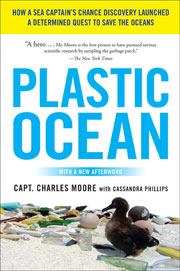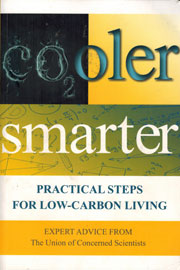By Victoria Parsons
If you’ve already given up on all those admirable resolutions to lose weight, exercise more and eat less junk food, consider making new resolutions that will help get our planet into better shape. Here are three books that take in-depth looks at the issues and then offer suggestions on ways you can make a difference.

In “Blue Revolution,” long-time Florida Trend reporter Cynthia Barnett takes readers on a trip around the world, looking at how communities have revolutionized water ethics. From the watery Netherlands to drought-stricken Singapore and Australia, she skillfully blends hard facts with intriguing anecdotes in her latest book on water conservation.
Her conclusion: it will be impossible for humans to continue to find “new sources” of water to meet growing demand but the right ethics and pricing will reduce water use so we can all have what we need.
Although water conservation hasn’t gotten the same celebrity attention that is focused on energy technology and conservation, she writes, it will eventually become an important issue – perhaps even in our lifetimes.
She shares the story of a friend who is an environmental historian who cites the transformation of America’s littering habits. While the population continued to grow, researchers found 61% less litter in 2009 than in 1969. Psychological research indicates that the top reason for the transformation was an ethical belief that littering was wrong.
“Someday, you may not want to be the only one with bright green grass,” she writes.
Of course, regular readers of Bay Soundings know that Tampa Bay’s per capita use is already below state and national averages – about 100 gallons per day compared to 158 for the state and 150 for the nation. The so-called “water wars” of the early 1980s forced the region to look at alternatives to cheap underground water that hasn’t happened in places like Nevada where the average consumption tops 200 gallons per day and costs remain low.
Still, in Tampa Bay and across the country, lawns are the largest national “crop” requiring 19 trillion gallons of water daily to survive. “In that spirit, the blue revolution begins in our own backyards,” Barnett writes. “Just as it’s no longer possible to give all the large water users as much as they want, any time they want, it’s no longer possible for every one of us to use 150 gallons a day from our ailing aquifers and rivers. It’s a lot like America’s bank accounts: we are seriously overdrawn for luxuries we didn’t even need.”

“Plastic Ocean” by Capt. Charles Moore is also less a “how to” book than a call for revolutionary thinking about how and why plastics are used. Known as the man who discovered the Great Pacific Garbage Patch, he reminds us all that plastic is made from petroleum, doesn’t biodegrade in any meaningful time frame – and when it does, it decays into fragments and then into nanoparticles that may pollute for centuries to come.
Horrified by the plastic fragments he had glimpsed on a recreational sail across the Pacific, he returned several years later with a contingent of scientists and a plan to randomly sample the area known to sailors as the “doldrums.” While the air is calm, the sea works somewhat like a fast-running drain in a sink, capturing water and moving it downstream – but also concentrating pollutants like plastics.
“On land,” Moore writes,” it’s soothing to think that all those bottles and wrappers, all that cheap plastic stuff we handle every day, winds up in a landfill, safely sequestered for polite society. But here in mid-ocean, we’re finding hordes of escapees from imperfect collection systems.”
While it’s nearly impossible to track plastic back to its source once it has broken into tiny pieces, Moore contends that much of the trash found in the Pacific gyre is land-based. Technologies for recycling plastic have not kept up with technologies (and demands) for new and increased uses.
He also was among the first researchers to take plastic from ugly litter to harmful pollutant, showing that small bits of plastic “adsorb” other pollutants. The doubly toxic plastic bits are consumed by small fish at the base of the food web as well as filter-feeding whales, sea turtles and seafaring birds like albatrosses.
There will come a tipping point, hopefully in the near future, he writes. “Pointless competition and unthinking consumption will be replaced by mindful acquisition of goods that are needed and will last.”

Finally, if you’re ready to take real-world steps to make a difference, check out “Cooler Smarter: Practical Steps for Low-Carbon Living”written by a group of researchers from the Union of Concerned Scientists. (And since a large portion of the contaminants in Tampa Bay come from fossil fuels, you can see a direct impact in your own back yard.)
The nicest thing about reading this book was its very clear focus on impacts. For instance, we all know that turning off lights when we’re not in a room is a smart way to save electricity. However, replacing old-fashioned incandescent bulbs with newer CFLs or LEDs has even more impact. Because the CFLs result in savings of about 75%, you’d have to turn your lights off for three of every four days to achieve comparable savings.
Another interesting comparison: leaving on computers, laser printers, coffee pots, digital cable boxes – anything with a clock or a light that glows to show it’s ready to run – may draw up to 500 watts of power, the equivalent of five 100-watt lights burning day and night.
Automobiles, of course, offer major savings in emissions but so do less expensive items like refrigerators, particularly if your family keeps an older model in the garage. The newer models are 20% larger and use 70% less electricity. You may be able to reduce your heating and cooling expenses by 15-25% with nothing more than a couple bucks worth of caulk to seal leaks.
Even saving water can make a difference in fossil fuel consumption. One study indicates that energy used to deliver water to homes in Southern California equals one-third of the household’s total use. Food choices are another often-ignored way to minimize emissions. Emissions from beef and pork are nearly 18 times higher than those from pasta.
I missed seeing that kind of comparison with solar or wind power, but the focus on easy-to-implement conservation methods more than made up for that loss. And it’s not only easy, it’s important. “If we improved the energy efficiency of residential buildings in this country by just 10% (a goal easily met by existing technology), Americans would save about $20 billion. Small individual improvements in energy efficiency can make a very big difference.”
[su_divider]
Originally published Winter 2013